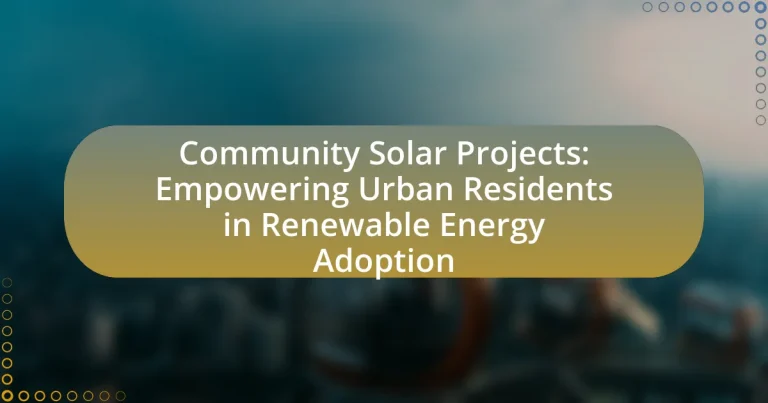Community solar projects are collaborative initiatives that enable urban residents, businesses, and organizations to invest in or benefit from shared solar energy systems without the need for individual solar panel installations. These projects function by allowing participants to subscribe to a solar array, receiving credits on their electricity bills based on their share of energy produced. Key components include solar arrays, subscription models, and community engagement, which collectively enhance access to renewable energy, particularly for those facing barriers such as limited rooftop space or financial constraints. Community solar projects not only promote energy equity and reduce costs but also contribute to local job creation and environmental sustainability by decreasing reliance on fossil fuels and lowering carbon emissions. The article will explore the importance, benefits, challenges, and best practices associated with community solar projects, emphasizing their role in empowering urban residents in the transition to renewable energy.

What are Community Solar Projects?
Community solar projects are initiatives that allow multiple participants, often in urban areas, to invest in or benefit from a shared solar energy system. These projects enable individuals, businesses, and organizations to access renewable energy without needing to install solar panels on their own properties. According to the National Renewable Energy Laboratory, community solar can increase access to solar energy for those who may not have suitable rooftops or the financial means to invest in solar technology individually, thereby promoting broader adoption of renewable energy sources.
How do Community Solar Projects function?
Community solar projects function by allowing multiple participants to invest in or subscribe to a shared solar energy system, typically located off-site. These projects enable individuals, businesses, or organizations to benefit from solar energy without needing to install panels on their own properties. Participants receive credits on their electricity bills based on the amount of energy produced by the solar array, which is proportionate to their investment or subscription level. This model promotes renewable energy access, particularly for those who may not have suitable rooftops for solar installations, thereby facilitating broader community engagement in sustainable energy practices.
What are the key components of Community Solar Projects?
The key components of Community Solar Projects include solar arrays, subscription models, and community engagement. Solar arrays are the physical installations that generate electricity, typically located on unused land or rooftops. Subscription models allow individuals or businesses to buy or lease a share of the solar energy produced, enabling access to renewable energy without the need for personal solar panels. Community engagement is crucial for educating residents about the benefits and logistics of participation, fostering a sense of ownership and collaboration among members. These components work together to make renewable energy accessible and beneficial for urban residents.
How do these components interact to deliver solar energy?
Solar energy delivery involves the interaction of photovoltaic panels, inverters, and the electrical grid. Photovoltaic panels convert sunlight into direct current (DC) electricity through the photovoltaic effect. Inverters then convert this DC electricity into alternating current (AC) electricity, which is compatible with the electrical grid. Finally, the AC electricity is fed into the grid, allowing it to be distributed to homes and businesses. This process enables urban residents to access renewable energy through community solar projects, which aggregate solar power generation for shared use.
Why are Community Solar Projects important for urban residents?
Community solar projects are important for urban residents because they provide access to renewable energy for those who may not have the ability to install solar panels on their own properties. Urban areas often have limited roof space and high-density living conditions, making individual solar installations impractical. Community solar allows residents to invest in or subscribe to a shared solar facility, enabling them to benefit from solar energy without the need for personal installations. According to the National Renewable Energy Laboratory, community solar can increase solar adoption rates by making renewable energy more accessible, particularly for low-income households and renters who traditionally face barriers to solar energy access.
What challenges do urban residents face in adopting renewable energy?
Urban residents face several challenges in adopting renewable energy, primarily including high upfront costs, limited access to suitable installation sites, and regulatory barriers. High upfront costs deter many residents from investing in solar panels or other renewable technologies, as the initial financial burden can be significant. Limited access to suitable installation sites, particularly in densely populated areas where space is constrained, restricts the ability to install solar systems effectively. Additionally, regulatory barriers, such as complex permitting processes and lack of supportive policies, hinder the adoption of renewable energy solutions. These challenges collectively impede urban residents from transitioning to renewable energy sources, despite the potential benefits.
How do Community Solar Projects address these challenges?
Community Solar Projects address challenges related to renewable energy access and affordability by allowing multiple participants to invest in a shared solar installation. This model enables urban residents, who may lack suitable rooftops for solar panels, to benefit from solar energy without the need for individual installations. According to the National Renewable Energy Laboratory, community solar can reduce energy costs by providing economies of scale, making solar power more affordable for low- and moderate-income households. Additionally, these projects often include provisions for equitable access, ensuring that diverse community members can participate and benefit from renewable energy, thus promoting inclusivity in the transition to sustainable energy sources.

What benefits do Community Solar Projects provide to urban communities?
Community Solar Projects provide urban communities with increased access to renewable energy, reduced energy costs, and enhanced energy resilience. These projects allow residents, particularly those who may not have suitable rooftops for solar panels, to participate in solar energy generation. By pooling resources, urban communities can benefit from economies of scale, leading to lower electricity bills; studies indicate that participants can save 10-20% on their energy costs. Additionally, Community Solar Projects contribute to local job creation in the renewable energy sector, fostering economic growth. According to the National Renewable Energy Laboratory, community solar can also enhance grid reliability by diversifying energy sources, which is crucial for urban areas facing energy demand fluctuations.
How do Community Solar Projects promote energy equity?
Community Solar Projects promote energy equity by providing access to renewable energy for low-income and underserved communities that may not have the means to install solar panels on their own properties. These projects allow participants to buy or lease a share of a larger solar installation, enabling them to benefit from solar energy savings without the upfront costs associated with individual solar systems. According to a report by the National Renewable Energy Laboratory, community solar can increase participation in renewable energy programs by 20% among low-income households, thereby reducing energy costs and fostering economic stability. This model not only democratizes access to clean energy but also helps to mitigate the energy burden faced by disadvantaged populations, promoting overall energy equity.
What role do Community Solar Projects play in reducing energy costs?
Community Solar Projects significantly reduce energy costs by allowing multiple participants to share the benefits of a single solar installation. These projects lower individual energy expenses through economies of scale, as the collective investment in solar infrastructure often results in lower per-unit energy costs compared to individual installations. For instance, a study by the National Renewable Energy Laboratory found that community solar can reduce electricity bills by 10-30% for participants, making renewable energy more accessible and affordable for urban residents.
How do these projects contribute to local job creation?
Community solar projects contribute to local job creation by generating employment opportunities in installation, maintenance, and management of solar energy systems. These projects typically require a skilled workforce for tasks such as site preparation, panel installation, and ongoing system upkeep, which can lead to the creation of hundreds of jobs in the local area. For instance, a report by the Solar Foundation in 2021 indicated that the solar industry employed over 250,000 workers in the United States, with community solar projects being a significant driver of this growth. Additionally, local economies benefit from increased demand for related services and materials, further enhancing job creation in the community.
What environmental impacts do Community Solar Projects have?
Community Solar Projects have several positive environmental impacts, primarily by reducing greenhouse gas emissions and promoting renewable energy use. These projects enable urban residents to access solar energy without needing to install individual systems, thus decreasing reliance on fossil fuels. According to the National Renewable Energy Laboratory, community solar can reduce carbon dioxide emissions by approximately 1.5 million tons annually for every 1,000 megawatts of solar capacity installed. Additionally, these projects can lead to improved air quality and reduced water usage compared to traditional energy sources, further contributing to environmental sustainability.
How do Community Solar Projects contribute to reducing carbon emissions?
Community Solar Projects contribute to reducing carbon emissions by facilitating the generation of renewable energy from solar sources, which displaces the need for fossil fuel-based electricity. These projects allow multiple participants, often in urban areas, to invest in and benefit from solar energy without needing to install panels on their own properties. According to the National Renewable Energy Laboratory, community solar can reduce greenhouse gas emissions by providing access to clean energy for those who may not have the means to adopt solar technology individually, thus promoting a broader transition to renewable energy sources. This collective effort leads to a significant decrease in reliance on carbon-intensive energy, ultimately contributing to lower overall carbon emissions in the community.
What are the long-term sustainability benefits of Community Solar Projects?
Community Solar Projects provide significant long-term sustainability benefits by promoting renewable energy adoption and reducing greenhouse gas emissions. These projects enable communities to harness solar energy collectively, leading to a decrease in reliance on fossil fuels. According to the National Renewable Energy Laboratory, community solar can reduce carbon emissions by approximately 1.5 million tons annually, equivalent to taking 300,000 cars off the road. Additionally, they enhance energy resilience by diversifying energy sources and providing access to clean energy for residents who may not have suitable rooftops for solar panels. This collective approach fosters social equity, allowing low-income households to participate in the renewable energy transition, thereby contributing to a more sustainable and inclusive energy future.

What are the challenges and barriers to implementing Community Solar Projects?
The challenges and barriers to implementing Community Solar Projects include regulatory hurdles, financing difficulties, and community engagement issues. Regulatory hurdles often arise from complex permitting processes and inconsistent policies across jurisdictions, which can delay project development. Financing difficulties stem from the need for substantial upfront capital and the challenge of securing investors, particularly in low-income areas where financial resources are limited. Community engagement issues involve the necessity of educating residents about the benefits of solar energy and overcoming skepticism or lack of interest, which can hinder participation. These factors collectively impede the successful deployment of Community Solar Projects, as evidenced by studies indicating that regulatory frameworks and community buy-in are critical for project viability.
What regulatory hurdles do Community Solar Projects face?
Community Solar Projects face several regulatory hurdles, including interconnection standards, net metering policies, and state-specific legislation. Interconnection standards can vary significantly by region, creating challenges for project developers in connecting to the grid. Net metering policies, which determine how solar energy credits are allocated to participants, can also differ, impacting the financial viability of these projects. Additionally, some states lack comprehensive legislation supporting community solar, leading to inconsistent regulatory environments that hinder project development. For instance, as of 2023, only 22 states and Washington D.C. have enacted laws specifically promoting community solar, limiting opportunities in states without such frameworks.
How can policy changes facilitate the growth of Community Solar Projects?
Policy changes can facilitate the growth of Community Solar Projects by providing financial incentives, regulatory support, and streamlined permitting processes. For instance, policies that offer tax credits or rebates for solar installations can lower the upfront costs for developers and participants, making community solar more attractive. Additionally, regulations that mandate utilities to procure a certain percentage of their energy from community solar can create a stable market demand. According to the National Renewable Energy Laboratory, states with supportive policies have seen a significant increase in community solar capacity, demonstrating that effective policy frameworks directly correlate with project growth.
What financing options are available for Community Solar Projects?
Community solar projects can be financed through various options, including direct ownership, third-party ownership, and public-private partnerships. Direct ownership allows communities or organizations to invest in solar installations, while third-party ownership involves leasing or power purchase agreements with solar developers. Public-private partnerships can leverage government incentives and funding to support project development. These financing methods enable communities to access renewable energy without significant upfront costs, making solar power more accessible to urban residents.
How can urban residents get involved in Community Solar Projects?
Urban residents can get involved in Community Solar Projects by participating in local solar initiatives, subscribing to community solar programs, or investing in shared solar installations. These projects allow residents to benefit from solar energy without needing to install panels on their own properties. According to the National Renewable Energy Laboratory, community solar can increase access to renewable energy for those who may not have suitable roofs for solar panels, thus promoting wider adoption of clean energy solutions.
What steps should residents take to participate in a Community Solar Project?
Residents should take the following steps to participate in a Community Solar Project: first, they need to research available community solar programs in their area. This involves identifying local solar developers or utility companies that offer community solar subscriptions. Next, residents should evaluate the terms of participation, including costs, savings, and contract length. After selecting a suitable program, residents must complete the enrollment process, which typically includes filling out an application and providing necessary documentation. Finally, residents should monitor their energy bills to confirm the savings from their participation in the community solar project. These steps ensure that residents effectively engage in renewable energy adoption through community solar initiatives.
How can residents advocate for more Community Solar Projects in their area?
Residents can advocate for more Community Solar Projects in their area by organizing community meetings to raise awareness and gather support. Engaging local government officials and presenting data on the benefits of community solar, such as reduced energy costs and increased access to renewable energy, can strengthen their case. For instance, a study by the National Renewable Energy Laboratory found that community solar can reduce energy bills by up to 20% for participants. Additionally, residents can collaborate with local environmental organizations to amplify their efforts and utilize social media campaigns to reach a broader audience, thereby increasing public interest and pressure on decision-makers to support the development of community solar initiatives.
What best practices should be followed for successful Community Solar Projects?
Successful Community Solar Projects should prioritize stakeholder engagement, transparent communication, and equitable access to benefits. Engaging local communities ensures that the project meets their needs and fosters support, as evidenced by the success of the Solarize campaigns in various U.S. cities, which increased participation by involving residents in the decision-making process. Transparent communication about project goals, financial structures, and expected outcomes builds trust and encourages participation, as demonstrated by the success of the Massachusetts Community Solar program, which has seen significant growth due to clear information dissemination. Lastly, ensuring equitable access to solar benefits, particularly for low-income households, is crucial; studies show that inclusive programs can increase participation rates by up to 30%, as seen in the California Community Solar Pilot Program.


